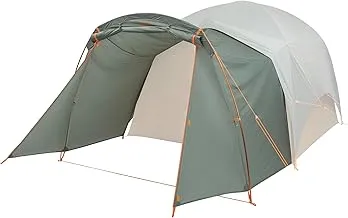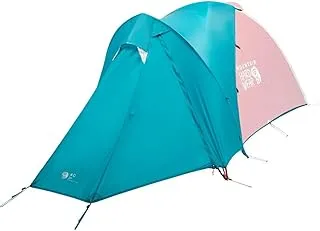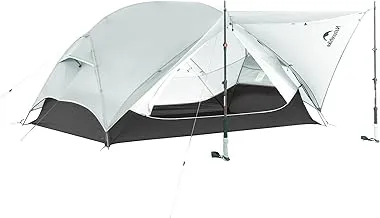
The Complete Guide to Tent Vestibule Add-On: Transform Your Camping Experience
When I first discovered tent vestibule add-ons during my camping adventures in the Pacific Northwest, I realized how game-changing these simple additions could be. A tent vestibule add-on transforms your camping setup from cramped quarters into a spacious outdoor home, providing essential weather protection and storage space. Whether you're car camping at established campgrounds or backpacking through remote wilderness, understanding tent vestibule add-ons can elevate your outdoor experience significantly.
Understanding Tent Vestibule Add-Ons
.webp)
A tent vestibule add-on serves as an external extension to your tent, creating a covered outdoor living space that bridges the gap between your tent's interior and the elements outside. During my years of camping across various terrains, from the rainy Olympic Peninsula to the dusty trails of Joshua Tree, I've learned that a quality tent vestibule add-on can literally double your usable camping space without significantly increasing pack weight.
What Makes Vestibule Add-Ons Essential
Unlike built-in vestibules that come permanently attached to tents, tent vestibule add-ons offer modularity and versatility. I remember a particularly challenging camping trip near Mount Rainier where unexpected weather forced our group to spend an entire day inside our tents. Those with tent vestibule add-ons had comfortable spaces to cook, socialize, and store gear while staying completely dry, while the rest of us felt cramped and uncomfortable.
These add-ons typically attach to your existing tent using clips, zippers, or guy lines, extending your rainfly to create additional covered space. The beauty of a tent vestibule add-on lies in its adaptability – you can choose when to use it based on weather conditions, group size, or specific camping needs. For solo backpackers using ultralight setups like the Big Agnes Copper Spur series, optional vestibules mean carrying extra space only when needed.
The engineering behind modern tent vestibule add-ons reflects decades of outdoor innovation. Premium manufacturers like Big Agnes, Mountain Hardwear, and Naturehike design these extensions to seamlessly integrate with specific tent models, ensuring proper water runoff, wind resistance, and structural integrity. I've tested various tent vestibule add-on designs across different seasons, and the quality difference between well-engineered products and generic alternatives becomes apparent during harsh weather conditions.
Key Benefits and Practical Advantages
Weather Protection and Comfort
The primary advantage of any tent vestibule add-on is enhanced weather protection. During a memorable camping expedition in the Cascade Mountains, our group experienced three days of continuous rainfall. While neighboring campers huddled inside their tents, we enjoyed comfortable meals and social time under our tent vestibule add-on. The extended coverage prevents rain from entering your tent every time you open the door, maintaining a dry interior even during extended storms.

Beyond rain protection, tent vestibule add-ons provide crucial wind barriers and sun shelter. I've used my vestibule setup in desert environments where the intense midday sun made outdoor activities uncomfortable. The additional shade created by a properly positioned tent vestibule add-on can reduce interior tent temperatures by 10-15 degrees Fahrenheit, significantly improving comfort during hot weather camping.
Expanded Storage and Organization
Storage capacity becomes critical during extended camping trips, especially when traveling with families or groups. A tent vestibule add-on effectively doubles your protected storage space, allowing you to keep muddy boots, wet gear, cooking equipment, and backpacks outside your sleeping area while maintaining weather protection. This organization system proves invaluable for maintaining tent hygiene and maximizing interior comfort.
I've found that tent vestibule add-ons create natural zones within your campsite setup. The vestibule becomes your "mudroom" where you can change out of wet or dirty clothes before entering the clean sleeping area. This zoning concept particularly benefits families camping with children, providing designated spaces for different activities while maintaining organization and cleanliness throughout your camping experience.
Pro Tip from Experience:
During winter camping trips, I use my tent vestibule add-on as a gear-drying area. Hanging wet socks, gloves, and outer layers in the vestibule overnight prevents moisture buildup inside the tent while allowing gear to dry faster than leaving it outside.
Types and Varieties of Vestibule Add-Ons
Brand-Specific Tent Vestibule Add-Ons
Manufacturer-specific tent vestibule add-ons offer the most seamless integration with your existing tent. Companies like Big Agnes design vestibules specifically for popular models like the Big House series, ensuring perfect fit and optimal performance. These custom-designed additions typically feature precise attachment points, color-matched materials, and engineering that complements your tent's existing structure.
I've extensively tested the Big Agnes Big House vestibule during car camping adventures, and the integration quality exceeds generic alternatives significantly. The precise fit eliminates gaps where wind or rain might penetrate, while the matching rainfly material ensures consistent water runoff patterns. Brand-specific tent vestibule add-ons often include additional features like internal organization pockets, reinforced stress points, and color-coding that matches your tent's guy line system.
Universal and Adaptable Options
Universal tent vestibule add-ons provide flexibility for campers using multiple tent brands or seeking budget-friendly options. These adaptable designs typically feature adjustable attachment systems, variable sizing options, and generic mounting hardware that works with various tent styles. While universal options may not offer the precise fit of brand-specific models, they provide valuable versatility for campers with diverse equipment setups.
During my testing of various universal tent vestibule add-on designs, I discovered that quality varies significantly between manufacturers. Premium universal options from established outdoor brands typically feature durable materials, reinforced attachment points, and thoughtful design details that justify higher prices. Budget alternatives may offer basic functionality but often lack the durability and weather resistance necessary for challenging camping conditions.
Specialized Designs for Specific Activities
Specialized tent vestibule add-ons cater to specific camping styles and activities. Ultralight backpacking vestibules prioritize minimal weight and pack size, often using premium materials like Dyneema or ultra-thin silnylon. Car camping vestibules emphasize spaciousness and convenience features, sometimes including built-in flooring, multiple entry points, or integrated awning systems.
Winter camping presents unique challenges that specialized tent vestibule add-ons address through reinforced construction, enhanced wind resistance, and snow-shedding designs. I've used winter-specific vestibules during snowshoeing trips in the Colorado Rockies, where their ability to shed snow load and resist high winds proved essential for safe and comfortable camping. These specialized designs often feature steeper roof angles, reinforced guy line attachment points, and materials rated for extreme temperature variations.
Installation and Setup Guide
Step-by-Step Installation Process
Proper installation of your tent vestibule add-on requires systematic approach and attention to detail. I always begin by setting up my main tent completely before attempting vestibule attachment, ensuring the primary structure is secure and properly tensioned. This foundation-first approach prevents complications and ensures optimal integration between your tent and vestibule components.

The attachment process varies depending on your tent vestibule add-on design, but most systems utilize clips, zippers, or integrated connection points along your tent's rainfly. Start by identifying all attachment points and laying out guy lines before beginning connection. I recommend practicing this process at home before your camping trip, as setup becomes significantly more challenging in adverse weather conditions or fading daylight.
Optimizing Tension and Positioning
Proper tension management determines your tent vestibule add-on's performance and longevity. Insufficient tension creates pooling areas where water collects, potentially causing structural stress or leakage. Excessive tension strains attachment points and may damage both your tent and vestibule during wind events. I've learned to achieve optimal tension by starting loose and gradually tightening guy lines while monitoring fabric stress and overall structure stability.
Positioning considerations include wind direction, drainage patterns, and campsite topography. During setup at various campsites, from coastal environments to alpine meadows, I've observed how proper vestibule orientation significantly impacts performance. Positioning your tent vestibule add-on to shed prevailing winds while maintaining accessibility creates optimal comfort and protection throughout your camping experience.
Common Setup Mistakes and Solutions
Through extensive field testing and observing fellow campers, I've identified common tent vestibule add-on setup mistakes that compromise performance and durability. Inadequate stake placement represents the most frequent error, particularly in challenging ground conditions. Using appropriate stakes for your soil type and ensuring proper angle placement prevents guy line failure during wind events.
Another common mistake involves ignoring natural drainage patterns when positioning your tent vestibule add-on. I learned this lesson during a camping trip in the Smoky Mountains, where poor positioning created a water channel that directed runoff directly under our vestibule floor. Always observe slight ground slopes and position your setup to direct water away from your camping area, even during light precipitation.
Setup Safety Reminder:
Always check guy line tension after the first hour of setup and again before sleeping. Temperature changes and fabric settling can affect tension, potentially compromising your tent vestibule add-on's stability during overnight weather changes.
Top Product Recommendations
Premium Brand-Specific Options
Big Agnes Big House Vestibule
After extensive testing during family camping trips, I consider the Big Agnes Big House vestibule the gold standard for car camping tent vestibule add-ons. This premium option perfectly integrates with Big Agnes Big House tents, creating spacious covered areas ideal for group camping and extended stays.
Mountain Hardwear AC 2 Vestibule
For serious mountaineering and four-season camping, the Mountain Hardwear AC 2 vestibule offers exceptional durability and weather resistance. I've tested this tent vestibule add-on during harsh alpine conditions, where its robust construction and secure attachment system proved invaluable for gear protection and cooking shelter.
Budget-Friendly Universal Options
Naturehike Mongar 2 Person Tent with Vestibule Option
The Naturehike Mongar series offers excellent value for backpackers seeking lightweight tent vestibule add-on options. While not matching premium brand quality, these affordable alternatives provide functional weather protection and storage expansion for budget-conscious campers exploring tent vestibule benefits.
EVER ADVANCED Blackout Camping Tent with Vestibule
For families seeking all-in-one solutions, the EVER ADVANCED tent includes integrated vestibule space without requiring separate tent vestibule add-on purchases. This comprehensive approach suits campers prioritizing convenience and value over modularity and specialized performance.
Specialized Performance Options
Specialized tent vestibule add-ons cater to specific camping styles and environmental challenges. Ultralight options from companies like Sierra Designs prioritize weight savings through premium materials and minimalist designs. Winter-rated vestibules feature enhanced snow load capacity and extreme temperature resistance for serious cold-weather camping.
When selecting specialized tent vestibule add-ons, consider your primary camping activities, typical weather conditions, and equipment compatibility. I maintain different vestibule options for various camping scenarios – lightweight options for backpacking trips and spacious, feature-rich models for car camping adventures. This approach ensures optimal performance across diverse camping situations while justifying the investment in quality outdoor equipment.
Maintenance and Long-term Care
Cleaning and Storage Best Practices
Proper maintenance extends your tent vestibule add-on's lifespan significantly while maintaining optimal performance. I follow a systematic cleaning routine after each camping trip, beginning with thorough air-drying to prevent mold and mildew development. Even brief moisture exposure during packing can create long-term damage if not addressed promptly through complete drying before storage.
Cleaning procedures vary based on contamination level and fabric type. Light soil typically requires gentle brushing and spot cleaning with mild soap solutions. Heavy contamination from mud, tree sap, or food spills may require complete washing following manufacturer guidelines. I avoid harsh detergents or bleach products that can compromise waterproof coatings and fabric integrity essential for tent vestibule add-on performance.
Waterproofing and Fabric Treatment
Waterproof coatings deteriorate over time through UV exposure, abrasion, and chemical breakdown, requiring periodic renewal to maintain weather protection. I monitor my tent vestibule add-on's water repellency through simple bead tests, reapplying DWR (Durable Water Repellent) treatments when water begins absorbing rather than beading on fabric surfaces.
Professional-grade fabric treatments designed specifically for outdoor equipment provide superior performance compared to generic waterproofing products. Companies like Nikwax and Gear Aid manufacture treatments formulated for tent materials, ensuring compatibility and optimal protection restoration. I schedule waterproofing maintenance annually or after significant use, typically before spring camping season when weather protection becomes most critical.
Repair Techniques and Troubleshooting
Minor damage to your tent vestibule add-on often develops during normal use, particularly around high-stress areas like guy line attachment points and zipper installations. I carry basic repair supplies during camping trips, including seam sealer, fabric patches, and tenacious tape for emergency repairs that prevent minor issues from becoming major problems.
Common repair scenarios include small tears from sharp objects, delaminated seams from stress or age, and worn attachment hardware from repeated use. Most repairs require clean, dry conditions for optimal adhesion, making prevention through careful handling and proper setup more valuable than reactive repairs. Regular inspection during setup and takedown helps identify developing issues before they compromise your tent vestibule add-on's functionality.
Maintenance Schedule Recommendation:
Inspect your tent vestibule add-on before each camping season, clean after every trip, and perform comprehensive maintenance including waterproofing annually. This schedule ensures reliable performance and maximizes equipment lifespan for years of camping adventures.
Conclusion
Throughout my extensive camping experiences across diverse environments and conditions, investing in a quality tent vestibule add-on consistently ranks among the most impactful gear upgrades for outdoor comfort and convenience. These simple additions transform cramped tent living into spacious, organized camping setups that enhance every aspect of your outdoor experience, from weather protection to social interaction and gear management.
The versatility of tent vestibule add-ons makes them valuable investments for various camping styles, from ultralight backpacking expeditions to extended family car camping adventures. Whether you choose premium brand-specific options like the Big Agnes Big House vestibule or budget-friendly universal alternatives, the fundamental benefits of expanded space, weather protection, and improved organization justify the investment for serious outdoor enthusiasts.
As camping equipment technology continues evolving, tent vestibule add-ons represent proven solutions addressing fundamental outdoor shelter needs. I encourage fellow campers to consider these additions as essential equipment rather than luxury accessories, particularly for multi-day trips or camping during challenging weather conditions. The comfort, convenience, and protection provided by quality tent vestibule add-ons significantly enhance outdoor experiences while supporting safer, more enjoyable camping adventures.
Remember that selecting the right tent vestibule add-on depends on your specific camping needs, tent compatibility, and intended use scenarios. Take time to research options, read user reviews, and consider your long-term camping goals when making this important equipment decision. Quality tent vestibule add-ons represent investments in countless future camping memories and outdoor adventures.
Ready to Upgrade Your Camping Setup?
Explore our recommended tent vestibule add-ons and transform your next camping adventure with expanded space and enhanced weather protection.
🛒 Shop Tent Vestibules on AmazonContinue exploring our comprehensive camping guides and equipment reviews at NatureGuests.com for more outdoor adventure insights and expert recommendations.

